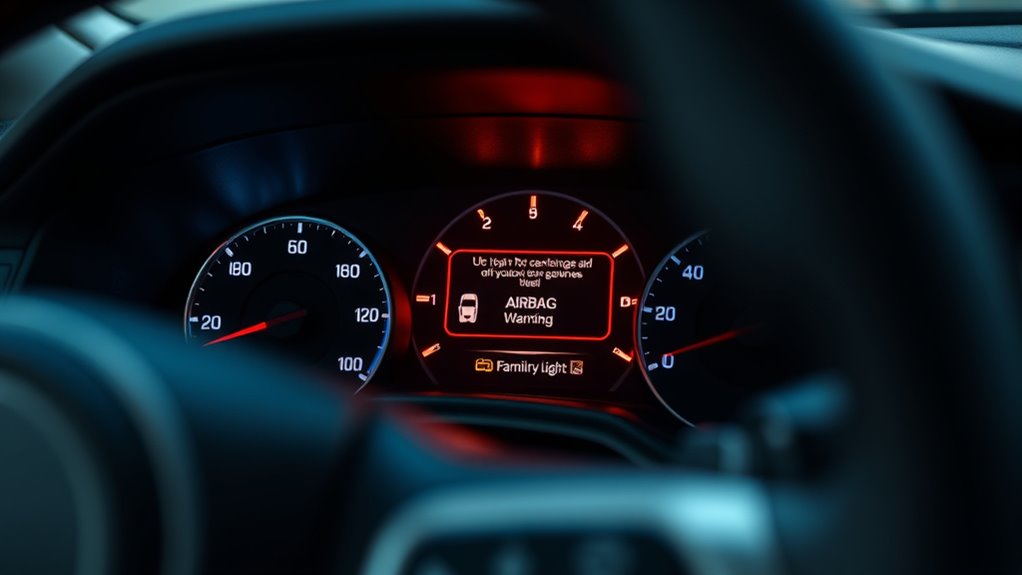How to Diagnose Airbag Light on in a Family Sedan Safety System
To diagnose the airbag light in a family sedan, you start by noting the light’s pattern and retrieving codes with an OBD-II scanner. Record stored and pending airbag (SRS) codes, then verify live data from sensors and the clock spring, connectors, and the airbag module. Check for loose wiring, corrosion, or damaged harnesses, and inspect the steering column and passenger area for obvious faults. If the light stays on, professional diagnostics will guide you to repair options and timing—you’ll learn more soon.
Understanding the Airbag Warning Light

The airbag warning light, typically shaped like a passenger airbag or a simple crash symbol, signals the vehicle’s airbag system is not ready for operation. You, as a driver seeking reliable diagnostics, observe this indicator to assess safety readiness. The light’s activation may reflect a fault in airbag functionality, a harness concern, or a sensor issue, rather than a generic warning. Distinguish between steady illumination, flashing patterns, and intermittent flickers, as each pattern points to different fault classes and required checks. Begin with data from the vehicle’s onboard diagnostic interface, noting fault codes related to restraint systems. Correlate codes with manufacturer service bulletins to determine likely failure modes without unnecessary disassembly. Verify that seat occupancy sensors, steering wheel clockspring, and wiring connectors are intact and undamaged. Maintain clear documentation of observed indicators and timeframes. This approach emphasizes precision, enabling you to gauge risk, plan corrective steps, and preserve airbag functionality for future travels.
How the Airbag System Is Supposed to Work

The airbag system is designed to deploy only when a collision exceeds a calibrated threshold, with airbags positioned to protect occupants based on seating position. You’ll learn how airbags deploy, how the system runs a diagnostic sequence, and how sensor data informs decisions in real time. We’ll cover the roles of sensors, control modules, and synchronized actuation to understand the overall operation.
How Airbags Deploy
Airbags deploy through a carefully timed sequence controlled by the airbag control unit and multiple sensors; when a collision exceeds predefined thresholds, the system activates to inflate the bags within milliseconds. You’ll observe a coordinated release: the inflator initiates, the bag rapidly fills with gas, and it emerges between occupant and hard surfaces. The sequence is synchronized to minimize injury risk, with timing adjusted for crash severity, occupant size, and seating position. Sensors monitor deceleration, angle, and impact vectors, signaling the control unit to deploy in a controlled order. This process relies on airbag mechanics that guarantee rapid, predictable performance, while safety regulations dictate testing, deployment criteria, and fault identification. Understanding this helps you assess system integrity without compromising your sense of freedom.
System Diagnostic Process
If the airbag system detects any fault, a dedicated diagnostic routine runs automatically to verify component integrity and sensor readiness. You’ll follow a structured sequence: the control module powers up, checks circuit continuity, and requests self-tests from individual devices. The process confirms bus communication, memory status, and optional simulator checks to validate fault-free states. Any detected discrepancy triggers a fault code and locks the system into a safe mode, prompting your immediate safety inspections. System troubleshooting then guides you through fault verification steps and reassessment after repairs, ensuring consistency with manufacturer limits. Documentation is essential; record codes, timestamps, and corrective actions. This diagnostic framework emphasizes repeatable, auditable checks, preserving system reliability while supporting your freedom to operate the vehicle with confidence.
Sensor Data Roles
Sensor data roles are foundational to how the airbag system determines deployment, since each input informs the control module about occupant presence, crash severity, and system readiness. You’ll map signals from impact sensors, seat sensors, and occupancy detectors to the central ECU, which analyzes timing, thresholds, and redundancy. Proper sensor calibration guarantees accurate interpretation of forces and positions, preventing false deployments or failures to deploy when needed. You’ll also monitor sensor health diagnostics, as a sensor malfunction can trigger the light even if the crash risk remains acceptable. The data pathway must remain clean, with cross-checks across channels to avoid single-point errors. In routine checks, verify wiring integrity and reference values, and document any irregularities for service alignment.
Common Causes for Airbags Not Deploying Properly

Common causes for airbags not deploying properly can often be traced to a few core issues that are straightforward to check. You’ll methodically verify fault sources, focusing on sensor integrity and system wiring. First, inspect airbag sensors for displacement, corrosion, or water ingress, since degraded sensors can miscommunicate crash data. Next, review the airbag control module connections; loose or damaged harnesses can interrupt signal transmission, creating deployment failures. Consider that a prior airbag replacement or module recall could introduce compatibility problems if parts aren’t matched to your vehicle’s VIN. Inspect clock springs in the steering column, which can fail with steering activity and degrade signal flow to the frontal airbags. Examine intermittent sensor wiring harnesses for chafing or pinched wires near the dash, doors, and trunk areas. Finally, check for diagnostic trouble codes that point to sensor malfunctions, which guides you toward root causes without unnecessary detours.
Quick DIY Checks You Can Do Safely
Here are four quick, safe checks you can perform to assess airbag readiness without specialized tools. You’ll methodically verify basic conditions, document results, and limit risk. First, inspect the passenger seat and floor for loose objects that could interfere with sensors or deployment. Next, confirm seat belts latch and retract smoothly, ensuring pretensioners won’t be falsely triggered. Then, verify dashboard indicator behavior: examine whether the light briefly illuminates on ignition and then off; abnormal patterns merit professional safety system checks. Finally, check the steering column area for obvious wiring damage or loose connectors that could disrupt signals.
| Step | Action |
|---|---|
| 1 | Inspect seat and floor for obstruction. |
| 2 | Check seat belt operation and pretensioner pathway. |
| 3 | Observe dash light pattern on startup. |
airbag maintenance tips, safety system checks. This concise checklist supports safe, informed maintenance without tools, aligning with broader airbag maintenance tips.
Reading Dashboard Codes and What They Mean
When you read the dashboard codes, you’ll first capture the stored fault codes from the airbag system and note their exact alphanumeric sequence. These codes point to specific subsystems or sensors, so you can map them to the corresponding diagnostic charts or manuals. Interpreting alerts requires cross-checking code meanings with vehicle year, model, and any recent repairs to guarantee accurate next steps.
Reading Diagnostic Codes
Reading diagnostic codes involves retrieving stored fault codes from the vehicle’s onboard computer and interpreting them to pinpoint airbag system issues. You’ll use diagnostic tools to access the airbag module and pull the codes, then cross-check against service manuals or databases for exact fault definitions. Start with a stable connection to the OBD-II port, power up the scanner, and select airbag or SRS data if available. Note the code(s) precisely, including any subcodes or MIL status, before clearing. Use code readers to verify whether recent resets affected readings. Document the sequence: code, meaning, severity, and recommended action. Keep your process systematic, avoiding assumptions; repeat checks to confirm consistency. This disciplined approach helps you move toward safe, informed repairs.
Interpreting Airbag Alerts
Interpreting airbag alerts requires translating dashboard symbols and fault codes into actionable diagnostics. You’ll map each warning light indicator to its likely failure mode, then prioritize tests that confirm system readiness without unnecessary disassembly. Begin with the light type (solid, blinking, intermittent) to estimate whether the issue is a sensor, harness, or module. Consult service literature for code meanings, but verify with live data: connector integrity, sensor resistance, and module communication. Document observed symptoms and vehicle conditions, as precise notes streamline airbag troubleshooting techniques. Avoid assumptions; cross-check codes from multiple cycles and ignition states. Keep safety in mind—disconnect power only after following proper procedures. When in doubt, isolate the suspected circuit, test with calibrated tools, and pursue fault isolation that preserves occupant protection.
What to Expect During a Diagnostic
During a diagnostic, expect a systematic approach: technicians will retrieve the vehicle’s fault codes, verify live data, and perform targeted tests to confirm the cause of the airbag light. You’ll witness a disciplined workflow, with clear steps and measurable outcomes. Diagnostic tools are used to cross-check sensor readings, harness integrity, and module communication. Safety protocols are followed at every stage to protect you and the vehicle. Expect focused data interpretation, not guesses.
| Step | Action | Outcome |
|---|---|---|
| Retrieve codes | Read I-CAN/OBD-II, stored and pending codes | List of relevant faults identified |
| Verify data | Compare live sensor values to spec | Anomalies pinpointed |
| Targeted tests | NDs, continuity checks, sim tests | Confirmed fault location |
This process emphasizes reproducibility and traceability, ensuring you understand what’s being checked and why. You’ll get a concise summary of findings, recommended next steps, and a clear rationale grounded in safety-focused diagnostics.
When to Seek Professional Help and Next Steps
After completing the diagnostic, you’ll know when professional help is warranted and what to reasonably expect next. In this stage, you assess safety implications and the reliability of your vehicle’s restraint system. If the light remains illuminated after basic checks, or if you encounter intermittent or repeated fault codes, seek professional inspection promptly. A qualified technician will verify wiring integrity, sensor function, and module health using manufacturer-specific scan tools, and they’ll determine whether a combined fault exists that requires service beyond DIY methods. Expect a structured assessment: confirm fault codes, inspect connectors for corrosion or damage, and test the airbag control unit’s standby and crash-sensing circuits. If a fault is confirmed, you’ll receive concrete repair options, including component replacement or recalibration, with associated costs and timelines. Prioritize repairs that restore full system integrity, and avoid delaying critical service, as the airbag system is a life-safety feature with limited tolerance for neglect.
Frequently Asked Questions
Can a Blown Fuse Cause the Airbag Light to Stay On?
A blown fuse can trigger the airbag light to stay on, yes. You’d notice a loss of power to the airbag system circuits, and the warning should persist until you replace the fuse and verify the circuit integrity. In your safety-focused workflow, inspect the fuse box, confirm the correct rating, and test the airbag system with a diagnostic tool. If the light remains, pursue professional diagnosis to rule out module faults or wiring damage.
Do Airbags Always Deploy in a Crash if Illuminated?
No. Airbags don’t always deploy in a crash just because the light is on. Airbag deployment scenarios depend on crash impact factors, sensor input, and system integrity. If the light’s illuminated, you shouldn’t assume deployment will occur; you could be at risk or the system may be disabled. You must have the system inspected promptly. A precise diagnostic checks sensors, wiring, and module status to confirm whether deployment would occur under specific crash conditions.
Will an Airbag Light Affect Seat Belt Pretensioners?
Yes, an airbag light can affect seat belt pretensioners. When the airbag system detects a fault, controls may disable pretensioner operation to prevent unintended deployment or safety risks. You should treat the issue as a combined airbag system problem, not isolated to airbags alone. For seat belt functionality, expect reduced protection until the diagnosis clears. Have a qualified technician inspect the airbag system and related wiring, sensors, and the control unit promptly.
Can Aftermarket Alarms Trigger the Airbag Warning Light?
Yes, aftermarket alarms can trigger the airbag warning light by drawing current or causing fault codes in airbag systems. You’ll see a rapid or steady illumination as the system detects an anomaly. To avoid false alarms, disconnect nonessential security modules during installations and use proper, certified interfaces. Verify with the vehicle’s diagnostics, reset after confirming no faults, and never ignore a lit airbag light—system integrity affects occupant safety and restraint performance.
Is Sensor Replacement More Costly Than Full Airbag Module Repair?
Sensor replacement is usually cheaper upfront, but total costs depend on fault type. If the sensor itself fails, sensor costs are lower than complete module repairs; however, module repairs can be necessary for harness or control unit damage. You’ll want a precise diagnostic to decide. In most cases, sensor costs are less than module repairs, but be prepared for additional labor, calibration, and possible replacement of related components to guarantee proper airbag system function.







